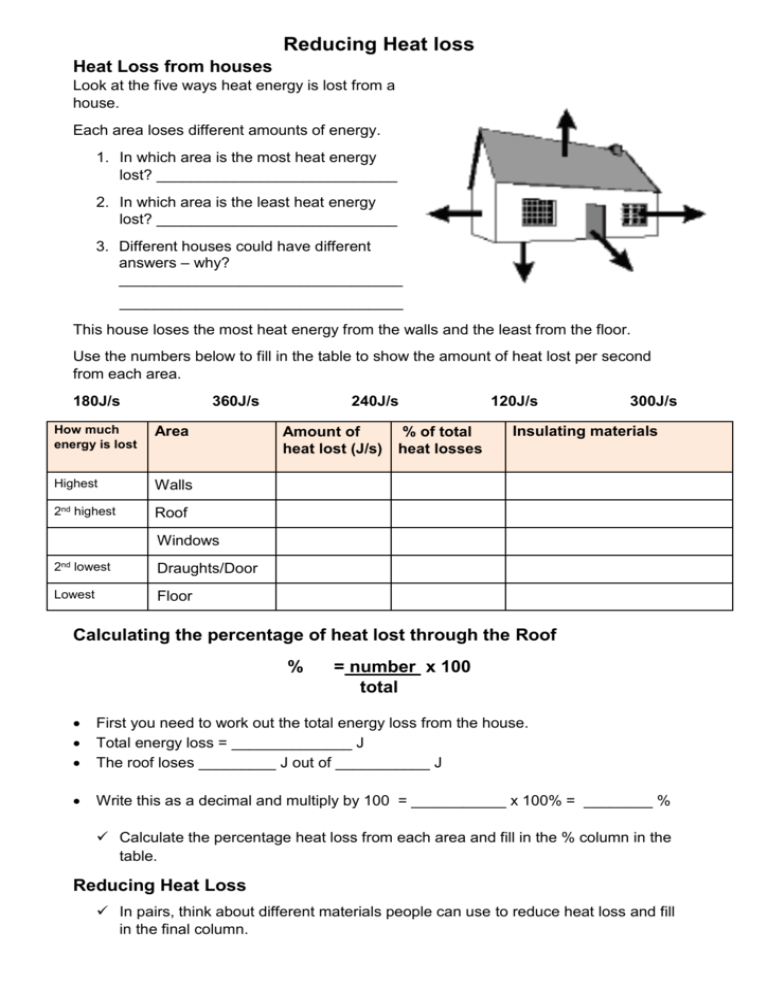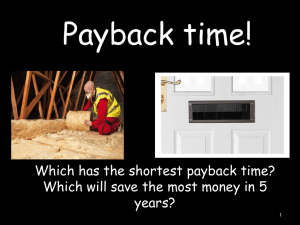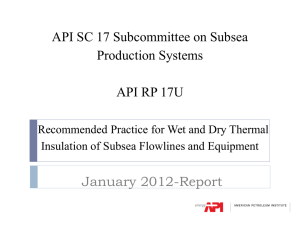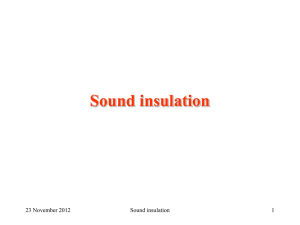6011-Reducing Heat Loss
advertisement

Reducing Heat loss Heat Loss from houses Look at the five ways heat energy is lost from a house. Each area loses different amounts of energy. 1. In which area is the most heat energy lost? ____________________________ 2. In which area is the least heat energy lost? ____________________________ 3. Different houses could have different answers – why? _________________________________ _________________________________ This house loses the most heat energy from the walls and the least from the floor. Use the numbers below to fill in the table to show the amount of heat lost per second from each area. 180J/s 360J/s How much energy is lost Area Highest Walls 2nd highest Roof 240J/s Amount of heat lost (J/s) % of total heat losses 120J/s 300J/s Insulating materials Windows 2nd lowest Draughts/Door Lowest Floor Calculating the percentage of heat lost through the Roof % = number x 100 total First you need to work out the total energy loss from the house. Total energy loss = ______________ J The roof loses _________ J out of ___________ J Write this as a decimal and multiply by 100 = ___________ x 100% = ________ % Calculate the percentage heat loss from each area and fill in the % column in the table. Reducing Heat Loss In pairs, think about different materials people can use to reduce heat loss and fill in the final column. By reducing heat losses, people can reduce how much energy they use. This means saving money on their energy bills. Practice exam question 1 • Energy consultants tell their customers how to save money. They explain how people can reduce energy loss from their homes. • This picture shows the percentage energy loss from different parts of a house. (b) Calculate the percentage energy loss through the walls of the house. ...................................................................................................................... (c) Suggest the two most effective methods of reducing heat loss for this house. 1 ................................................................................................................... 2 ................................................................................................................... Reducing energy consumption By reducing heat losses, people can reduce how much energy they use. This means saving money on their energy bills. Some ways of reducing heat loss are very expensive. People need to think about 3 things before they spend money on insulating these areas. 1. Installation Cost 2. Savings from energy losses 3. How long will you live in the house. Payback time This is the time in years to get back the money you have spent on insulation from the savings you have made. Payback time = Cost of installing Savings Calculate the payback time for each method and fill in the table below. Hint - the savings are made from the energy losses Where is heat lost? Cost of energy losses (£) Method Installation cost (£) roof 250 Fibre glass insulation 300 walls 350 Foam filled cavity wall insulation 1050 windows 300 Double glazing 4500 Payback time (years) doors 80 Draught proofing 40 Cost effectiveness This compares the TOTAL SAVINGS made over a few years compared to the cost of the insulation. Using the information in the table, work out the profit made after 5 years for: 1. Draught proofing How much is saved in 1 year? = _____ How much is saved in 5 years? = _____ What profit is left over? = 2. Roof insulation. How much is saved in 1 year? = _____ How much is saved in 5 years? = _____ What profit is left over? = Hint – don’t forget to take away the cost of the installation Answers Savings from draught proofing = __________ Savings from Fibre glass insulation = ________ So which method of insulation is the most cost effective over 5 years? ______________________________________________________________________ So, when answering questions, you need to look at: whether or not you will get back your money (payback time) AND if you do get your money back, how do the total savings over time compare to the cost (profit) PAYBACK TIME & PROFIT Practice exam question 2 The table shows the installation costs and yearly savings on energy bills for different methods of insulating a house. a) Give one reason why loft insulation is often fitted to an old house before double glazing or cavity wall insulation. _______________________________________________________ b) The time it takes for the saving on energy bills to equal the cost of installing the insulation is called the pay-back time. Calculate the pay-back time for loft insulation ______________________________________________________________ Pay-back time = ____________________ years (2 marks) Practice exam question 3 The table gives information about some ways of reducing the energy consumption in a house. Which way of reducing energy consumption is most cost effective over a 10 year period? To obtain full marks you must support your answer with calculations. Hint – you need to work out the profit. _____________________________________________________________________ _____________________________________________________________________ _____________________________________________________________________ _____________________________________________________________________ _____________________________________________________________________ _____________________________________________________________________ _____________________________________________________________________ _________________________________________________________________ (3 marks) Practice exam question 4 The diagram below shows a house which has not been insulated. The cost of the energy lost from different parts of the house during one year is shown on the diagram. The total cost of the energy lost during one year is £1000. a) What is the cost of the energy lost through the floor? (show your working out) _______________________________________________________ (2 marks) b) Suggest one way of reducing this loss. ________________________________________________________ (1 mark) The table below shows how some parts of the house may be insulated to reduce energy losses. The cost of each method of insulation is also given. c) Which method of insulation would you install first? Explain why. _____________________________________________________________________ _____________________________________________________________________ _____________________________________________________________________ _______________________________________________________________ (3 marks) d) Which method of insulation would you install last? Explain why. _____________________________________________________________________ _____________________________________________________________________ _____________________________________________________________________ ________________________________________________________________ (3 marks) Practice exam question 5 The diagram shows how much heat is lost each second from different parts of an uninsulated house. Each year the house loses £760 to heat. a) What percentage of energy is lost through the roof? __________________________________ b) How much money is being wasted though the roof? ________________________________________ c) Insulating the loft would cut the heat lost through the roof by 50%. How much money would loft insulation save every year? _________________________________________________________________ d) The loft insulation has payback time of 1.5 years. How much did the loft insulation cost to buy? _________________________________________________________________ _________________________________________________________________ Cost of loft insulation = £ ___________ (4 marks) Answers Exam question 2 a) most cost effective = 1 mark accept it is cheaper or lowest cost accept shortest payback time accept in terms of reducing heat loss by the largest amount do not accept it is easier ignore most heat is lost through the roof b) 4 years = 1 mark Exam question 3 hot water boiler = 1 mark four calculations correctly shown = 2 marks 200 × 10 – 1800 = £200 100 × 10 – 2400 = –£1400 50 × 10 – 600 = –£100 20 × 10 – 75 = 125 accept four final answers only accept obvious rejection of solar water heater and underfloor heating, with other two calculations completed any 1 complete calculation correctly shown = 1 mark showing each saving × 10 of all four calculations = 1 mark Exam question 4 a) 1000 – (250 + 350 + 100 + 150) or 1000 – 850 = 1 mark Answer = £150 = 1 mark b) (Named) floor covering OR Insulation under floor = 1 mark c) Draught proof doors or fibre glass in loft or foam filled cavity There is one mark for the method with 2 marks for the explanation. draught proofing 1 mark for choosing draught proofing Very low cost/easy to install Repays for itself quickly/cost recuperated quickly Reasonable energy saving any 2 for 1 mark each For loft insulation 1 mark for choosing loft insulation Second lowest installation cost/easy to install Reasonable large energy savings for this cost Reasonable payback time any 2 for 1 mark each For foam filled cavity 1 mark for choosing loft insulation Biggest energy/cash saving Cost effective any 2 for 1 mark each d) Double glazing gains 1 mark Costs most Saves least energy Least cost effective any 2 for 1 mark each Exam question 5 a) 25% = 1 mark b) £190 = 1 mark c) £95 = 1 mark d) £142.50 = 1 mark








